You may not find this terribly rewarding unless you're included here, so this is a good time for casual and random browsers to turn back before they get too caught up in the sweep and majesty of the proceedings and can't let go.
25 October 2018

Morning in Mondovì's Piazza old town -- we're off to see some of the sights.

Piazza's Piazza Maggiore -- the workmen are getting ready for the 21st Regional Festival of the Truffles, coming up 1-4 November. (The slogan is Peccati di Gola, insensitively translated as 'Sins of the Throat'.)
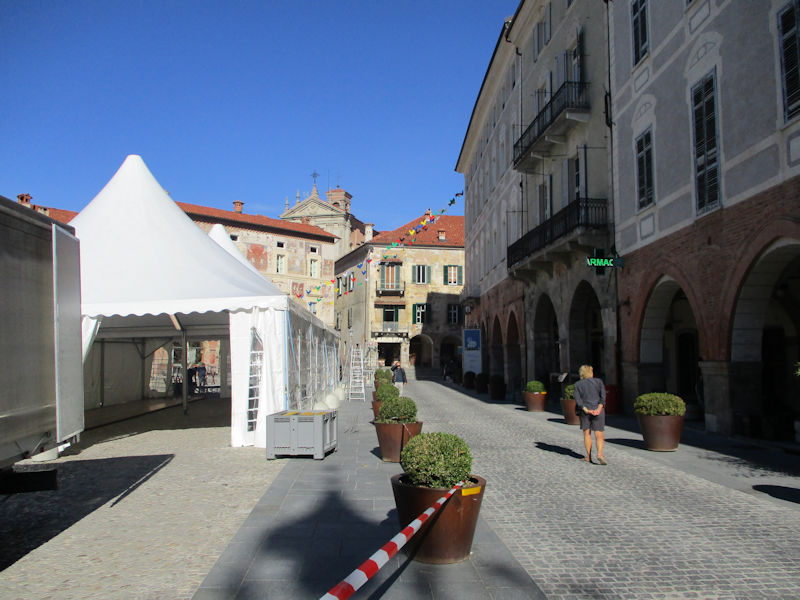
Refreshing our collective memory about which restaurants are closed on which nights.
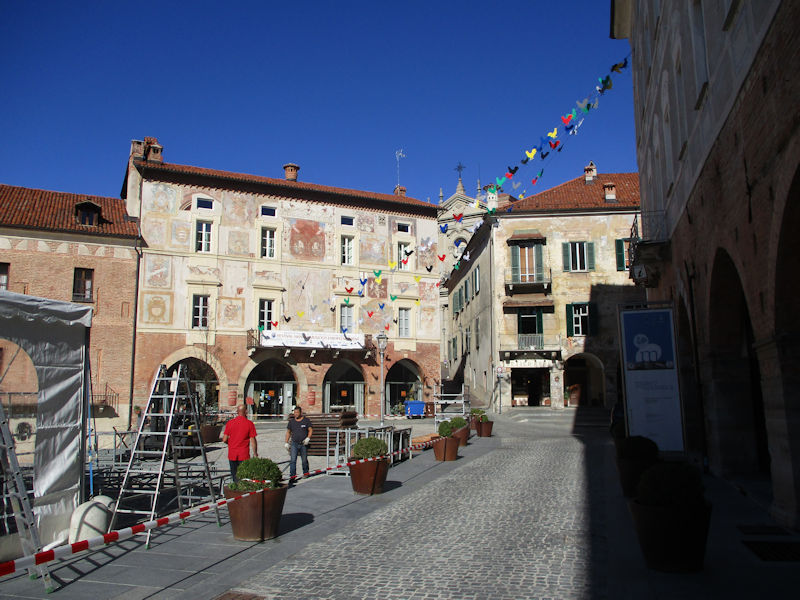
The north end of the Piazza Maggiore, with the Duomo just up the hill behind
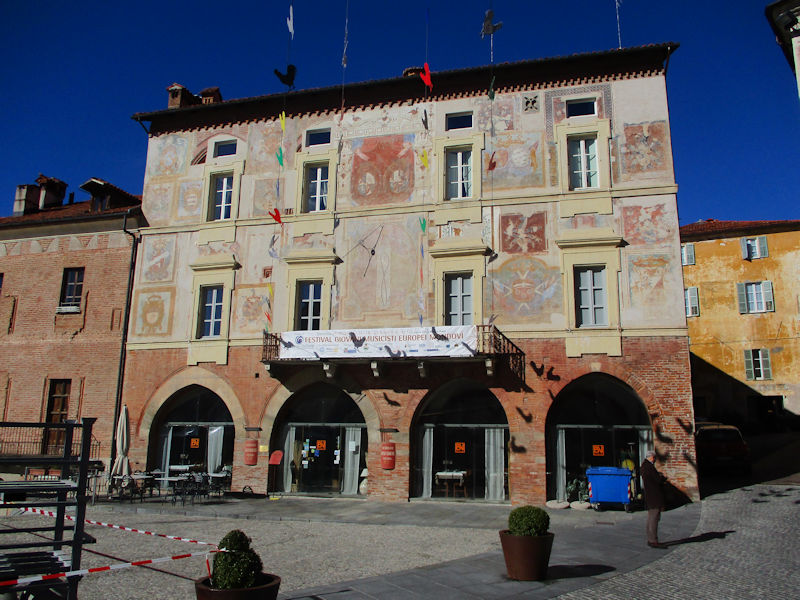
The Palazzo del Governatore, with the Pizzeria Belvedere
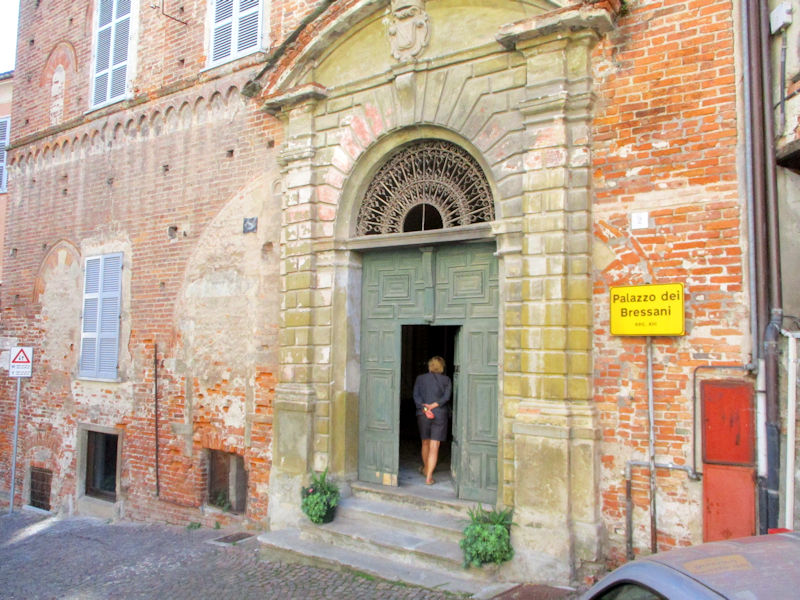
The Palazzo dei Bressani, 13th century home of the ruling family soon after the city's founding in 1198. That's as far as we got in our exploration of the building; the rest is locked up tight.
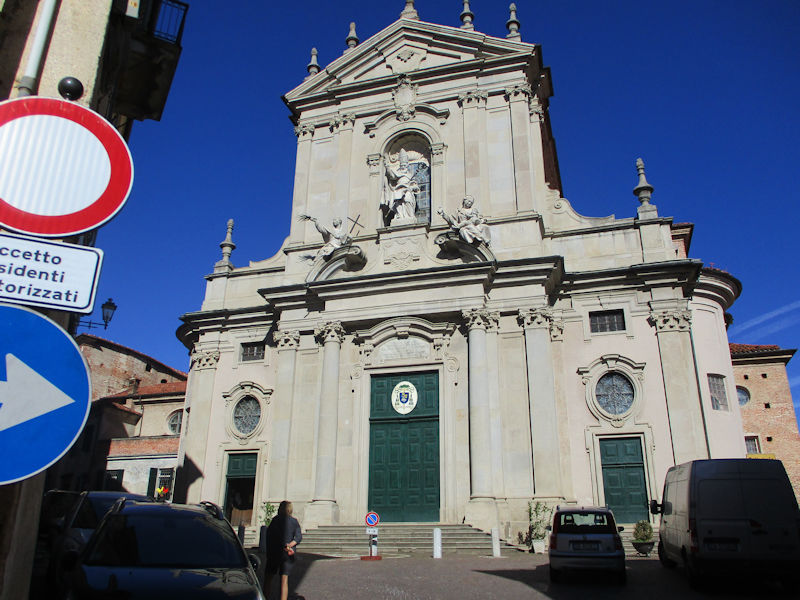
The Duomo, or Cattedrale di San Donato. We're on one high point of the old upper town, and there's another high point above the far end of the Piazza Maggiore. There the existing pieve of St Donato was commissioned as the cathedral when Mondovì, as part of the chase after allies between the two popes in the Great Schism, was created as a diocese by Pope Urban VI in 1388.
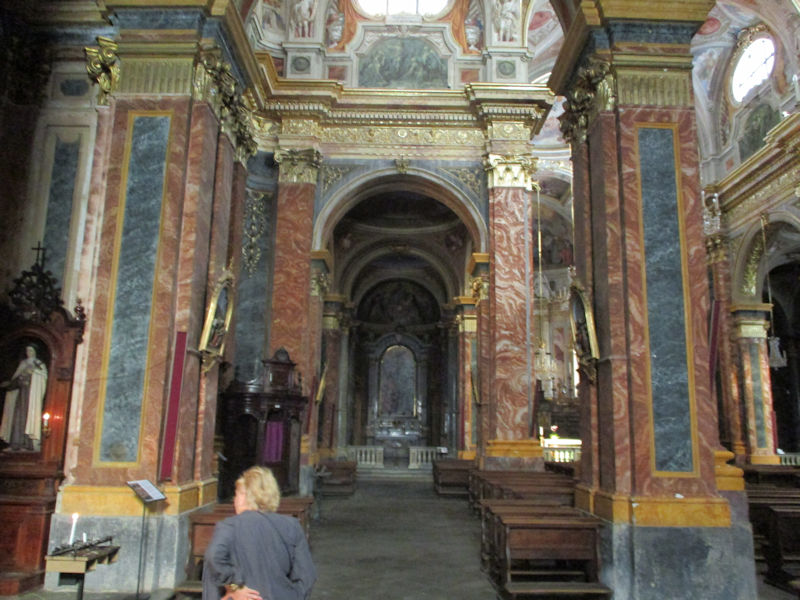
In the early 16th century, a more suitable cathedral was built on that other high point, but in 1574 the Savoyard Duke Emmanuel Philibert applied to the papacy to have that demolished to make room for the defensive fortress, or citadel, that he felt was necessary for security. The Savoy fortress was built in 1577 and the religious orders of a chain of other churches in town had to swap around, and the Church of San Francesco was put in service as the seat of the bishopric.
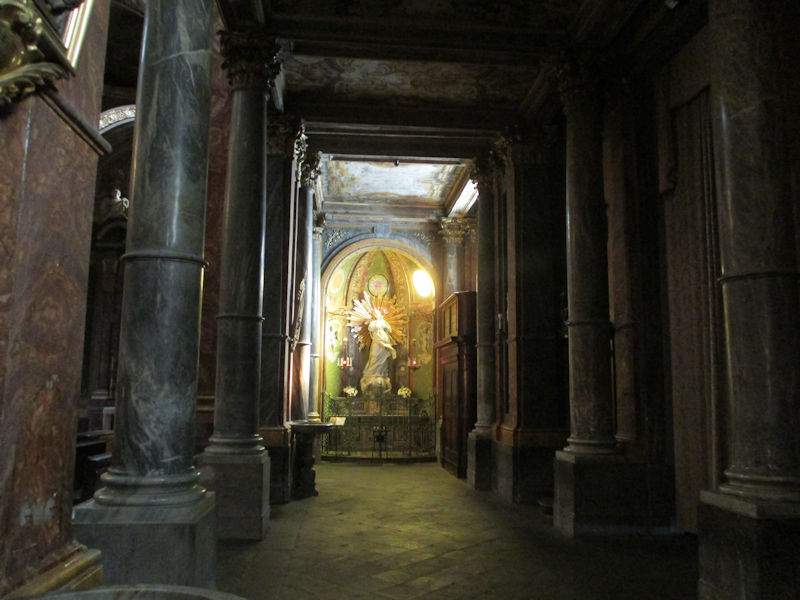
That looks potentially interesting.

Perhaps a Madonna -- but then we notice the serpent with the apple in its mouth.
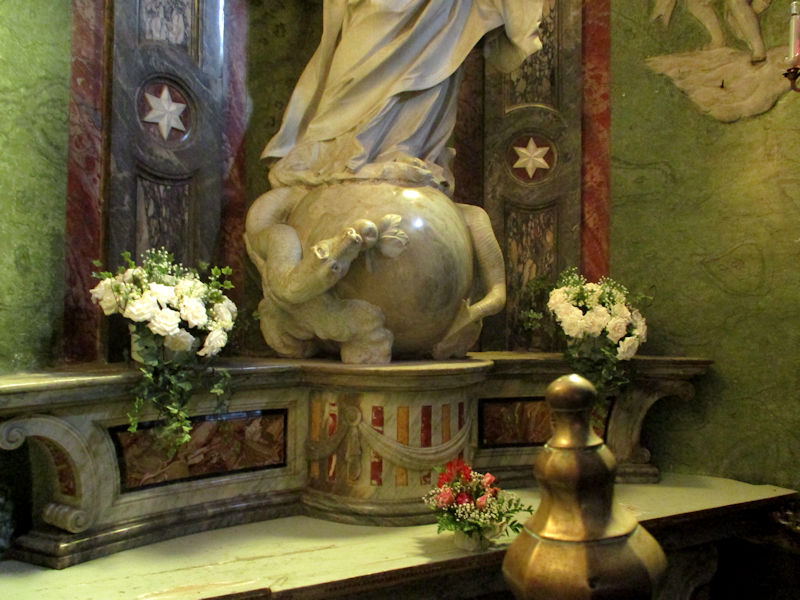
The serpent must be wondering how to convince Eve to eat the Apple of Knowledge of Good and Evil without dropping the Apple.
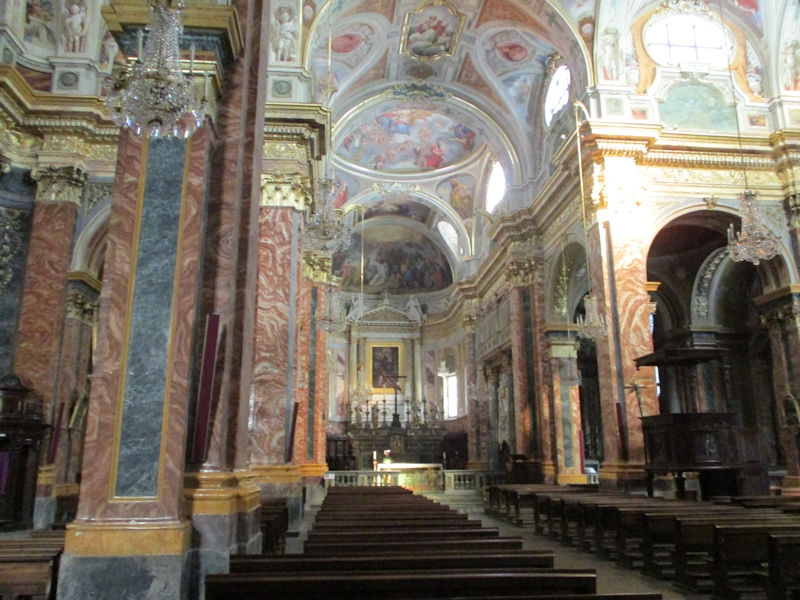
Finally this building, overlooking the city from the north end, was designed by Francesco Gallo and built between 1743 and 1753. It contains art and decorations from its predecessor churches but most of the paintings are from local artists of the 17th and 18th centuries, with elaborate stucco work from the mid-19th.
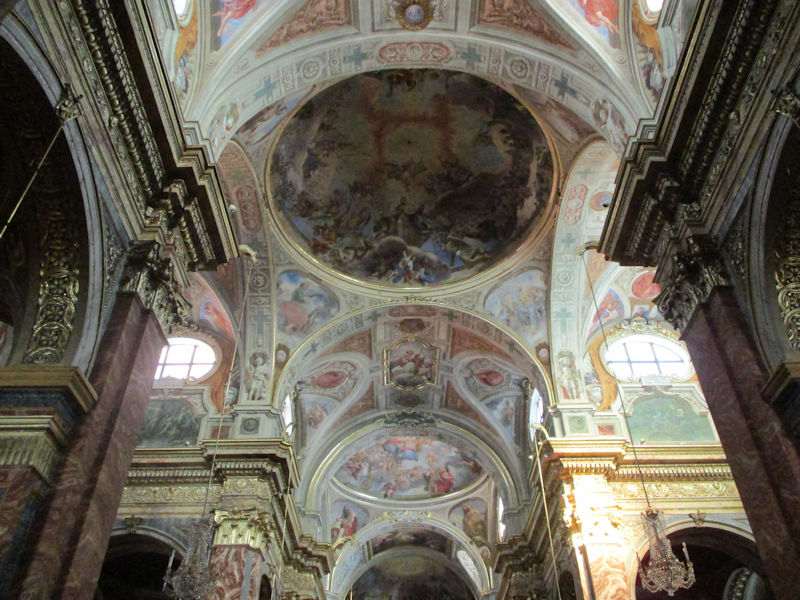
St Donatus, Bishop of Arezzo, supposedly martyred in 362, is the patron saint of both this cathedral and this city.
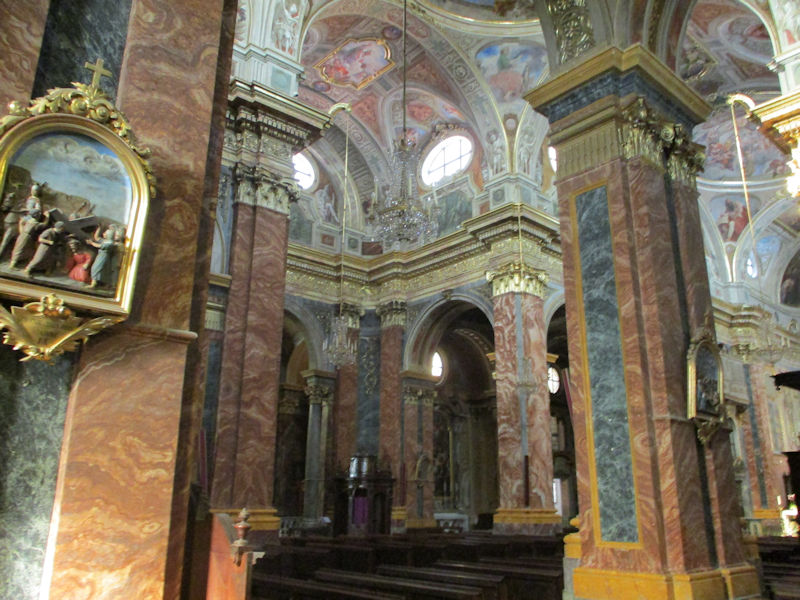
The decoration is overdone, to our taste, but there are so many interesting angles.
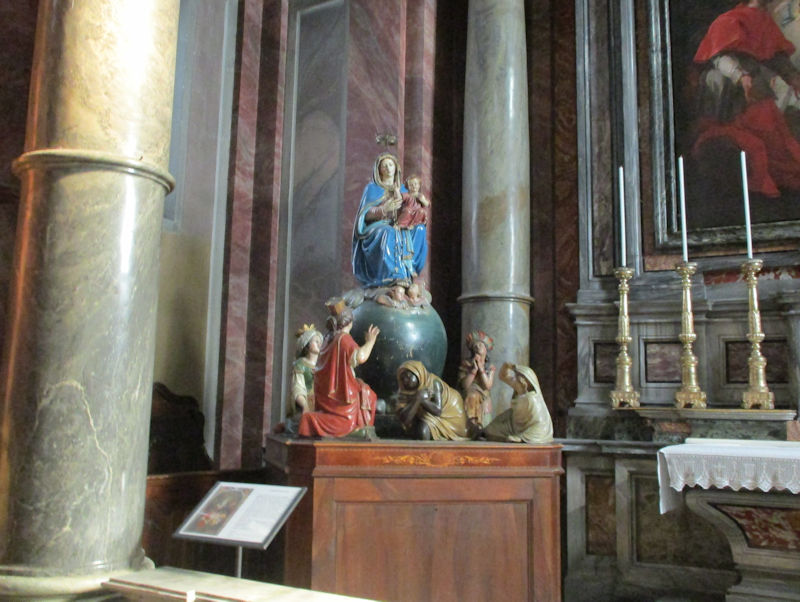
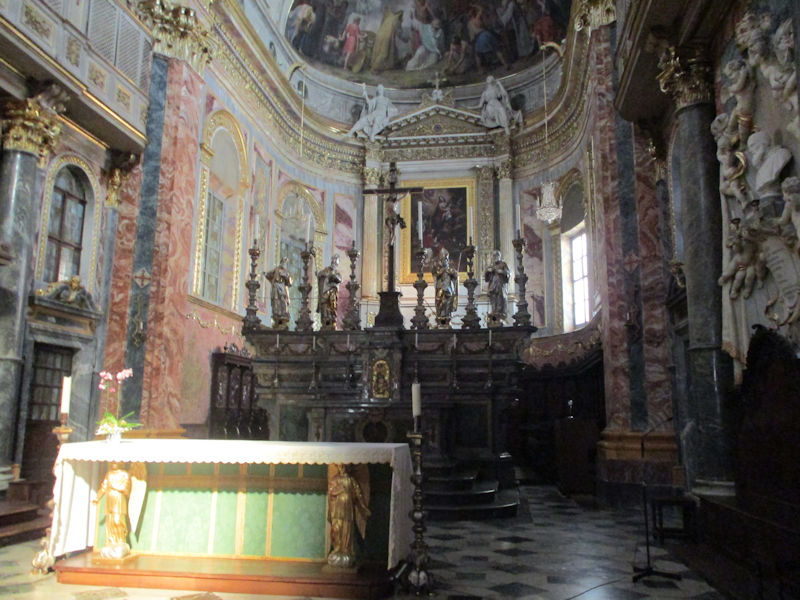
The altar was brought here from the 1507 Renaissance church that was demolished for the Duke's fortress.

The Last Supper -- the main course on the plate in the centre appears to be slab of liver, or foie gras.
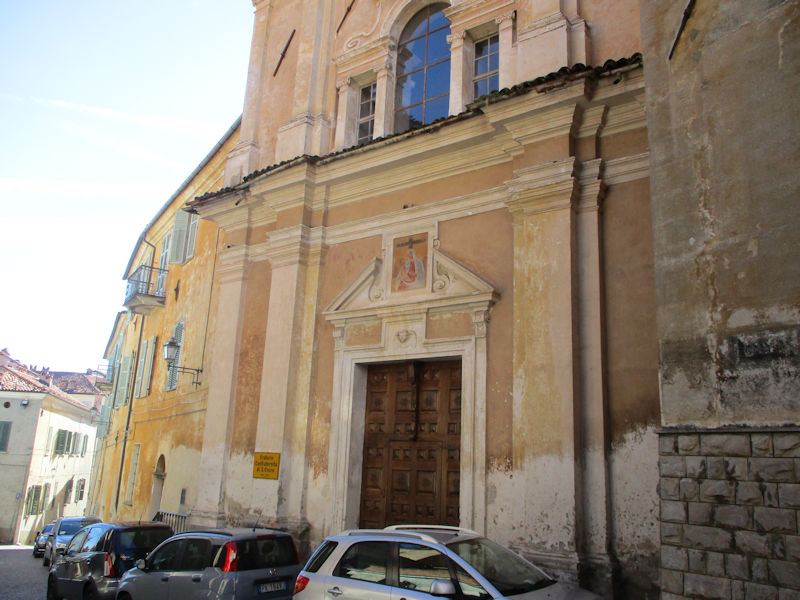
The Oratorio Confraternita di S. Croce. In the sign for the Sale del Vescovado next door, and its 'Hall of Degrees', closed today or perhaps always, there's a reference to a Rubens' mural and a Bernini crucifix. The small print elaborates that the mural's by a Flemish artist, Van den Hecke, from a sketch by Rubens, and the ivory crucifix might be by Bernini.
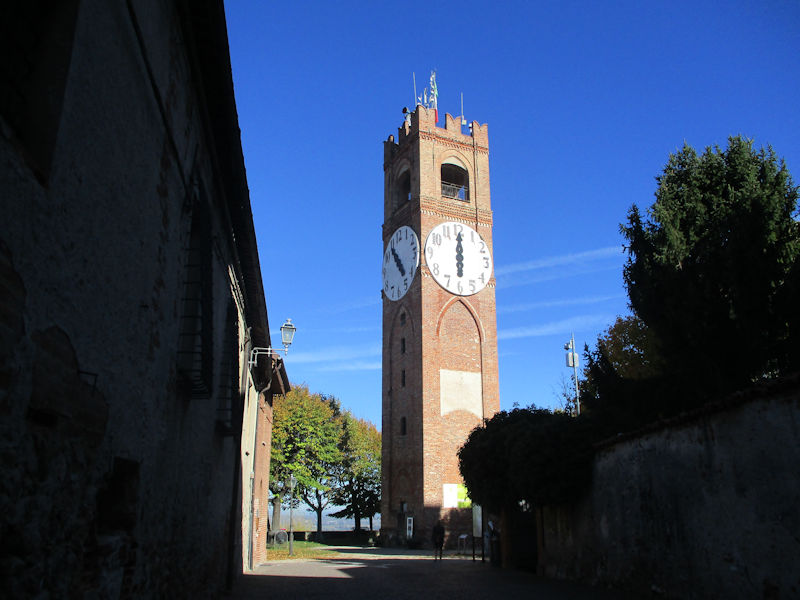
In the Parco del Tempo at the top of the village, here's the Civic Tower with its famous (and strange) clocks to 'scandire il Tempo' or 'beat time' (with only one clock hand evidently), and a clock museum inside (closed), and its Belvedere Gardens with their various solar clocks. The tower was originally the 14th century belltower of the church of Sant'Andrea, demolished in 1802 -- it's also called the Torre de Bressani after a ruling family of the time, whose 13th century palace down the street we just failed to get into.
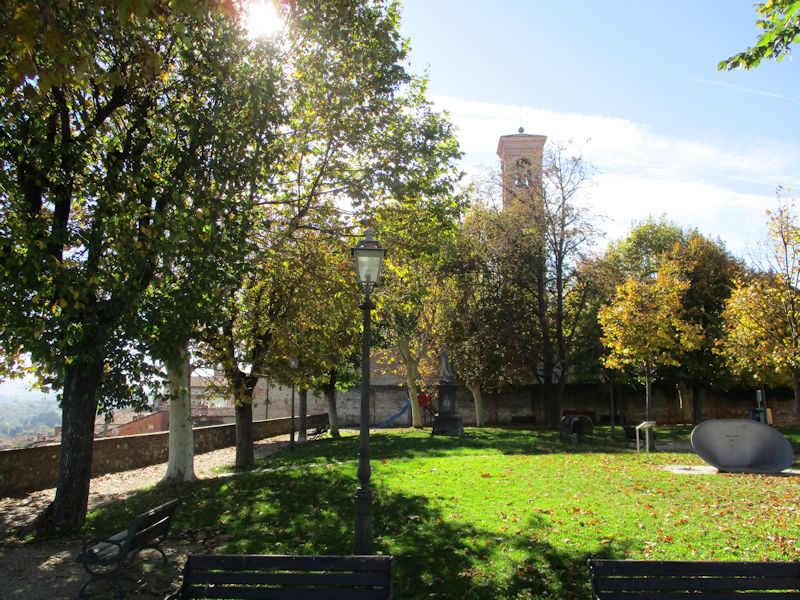
The Giardini del Belvedere
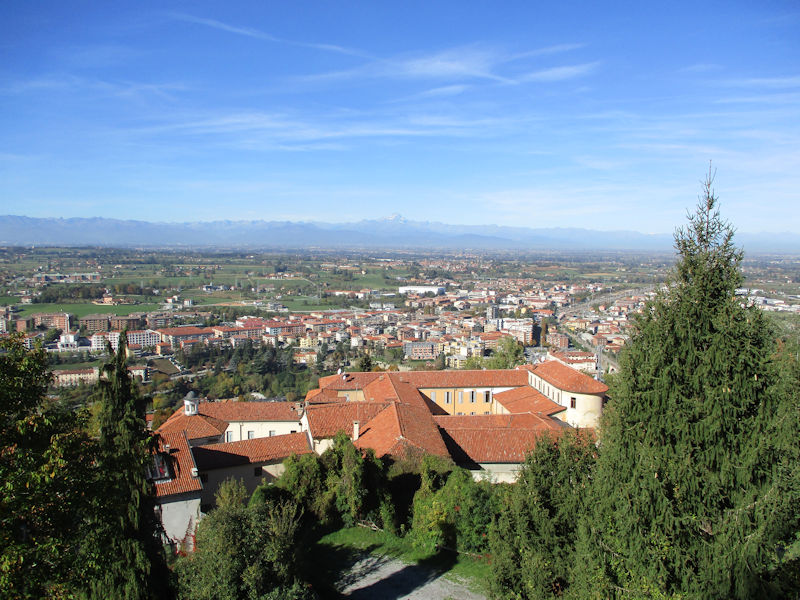
Views over Cuneo and Saluzzo, etc., in the distance, to Monte Viso
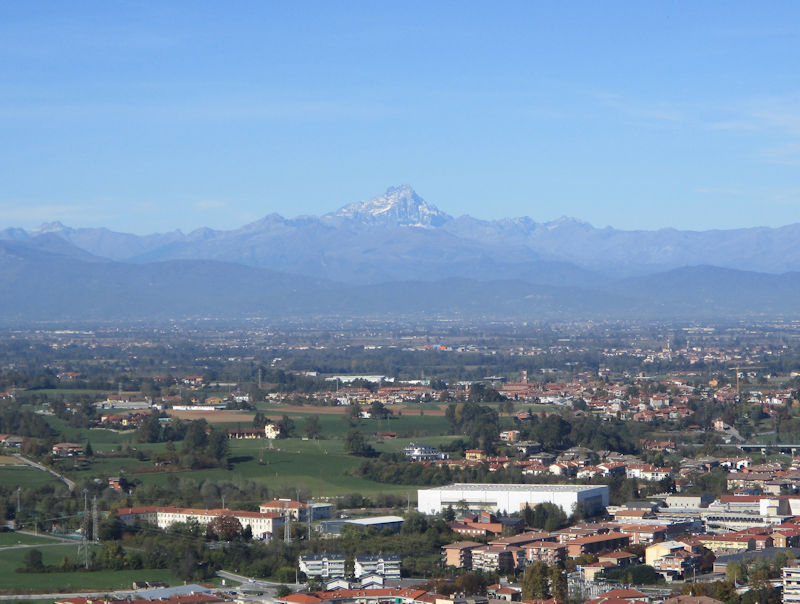
Monte Viso reigns supreme


We're going to try getting round the back of the cathedral.
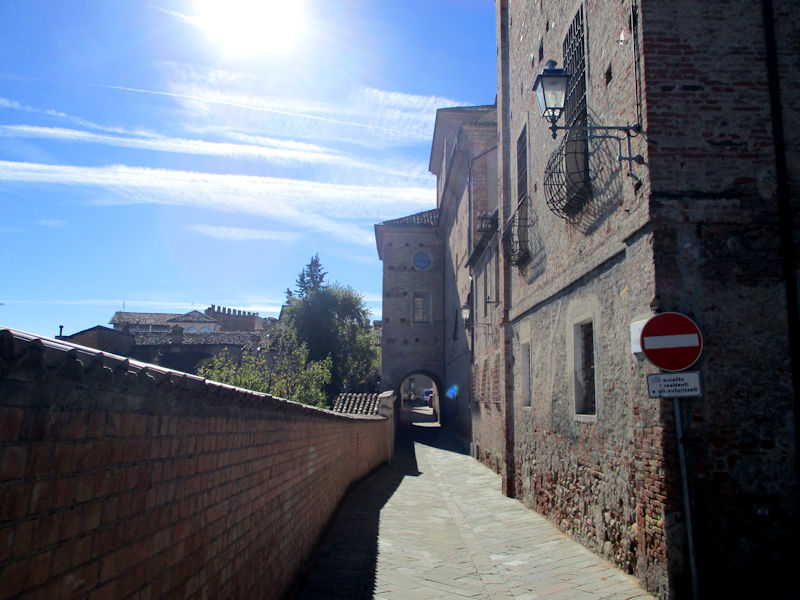
Behind the Duomo
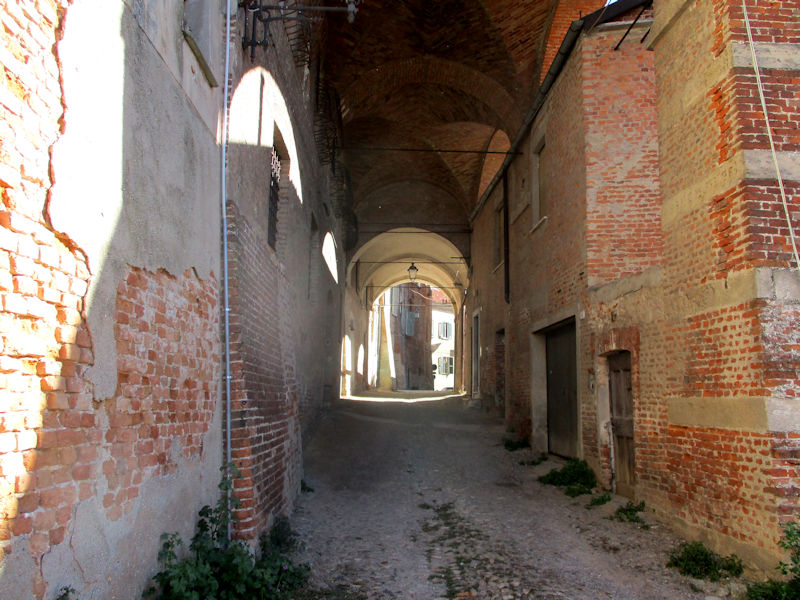
Back to the Piazza Maggiore
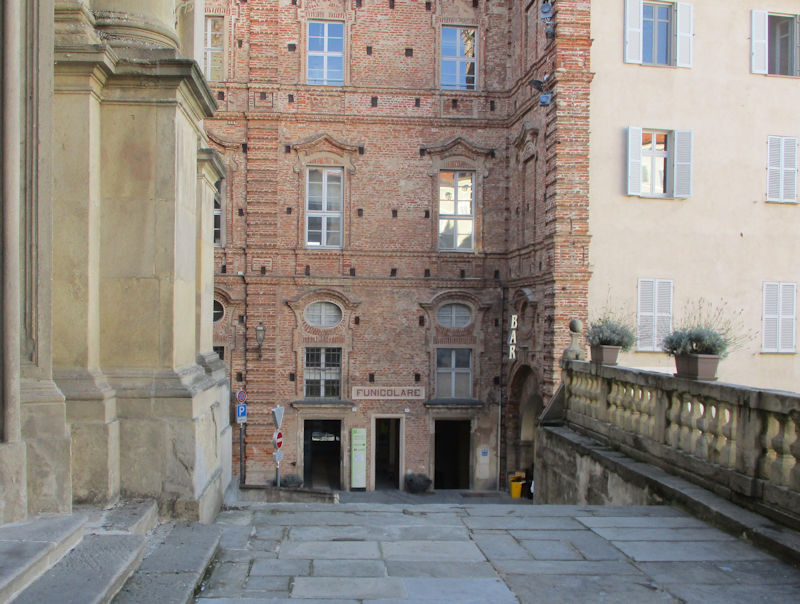
The funicular down to Breo

The small café under the arcades next to the funicolare (Caffè dell'Angolo, the Corner Café) is run by a friendly young man, who evidently puts in 14 hour days, and who provided Kristin with two glasses of cappuccino every morning to bring back to the apartment (and later return the glasses).

Down the funicular. Its first incarnation was opened in 1886, electrified in 1926, but put out of service in late 1975. Following reconstructions it was reopened in 2006. (What on earth did the suffering residents do in the meantime?) It's got a 550m course and rises about 140 vertical meters; it runs every 10 minutes from roughly 8 am to 8 pm, to midnight on weekends, and costs a bit less than 2 euros for a round trip.

Passing the uphill car -- they're apparently on the same cable.
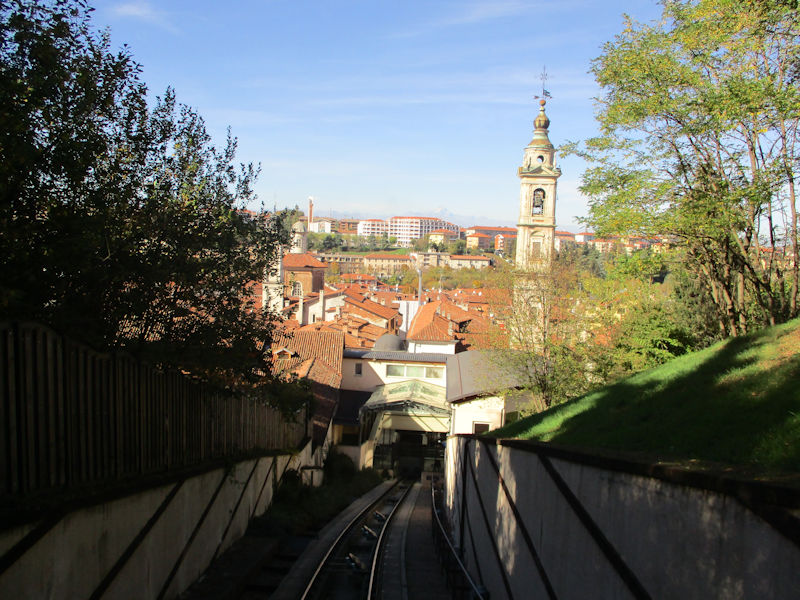
The base station, built in 2006

Just off the train in Mondovì Breo -- St Peter's Square

The Parrocchia dei Santi Pietro e Paolo, dating from 1464, with major transformations in 1722 by the ubiquitous regional architect Francesco Gallo (1672-1750). There is an automaton above the clock from 1798.
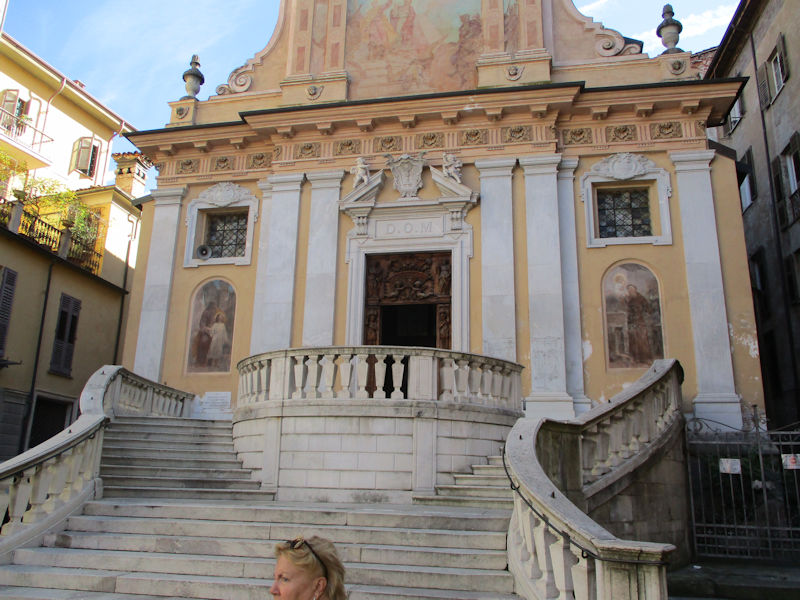
An interesting Baroque staircase
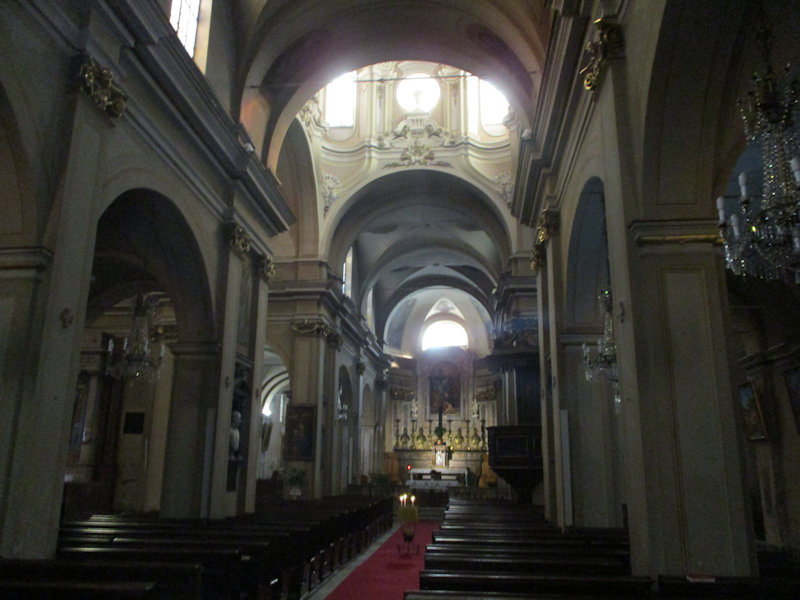
Not too much to say
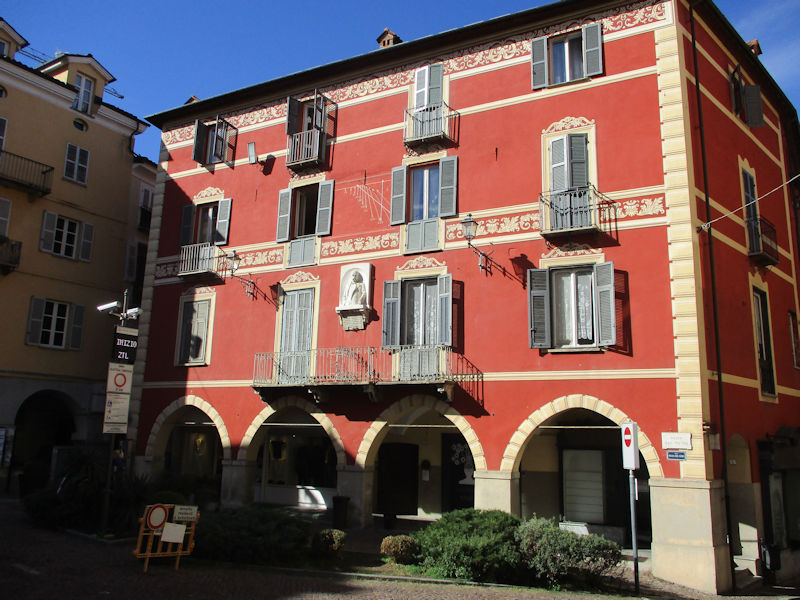
Across from the church

The railway bridge over the river
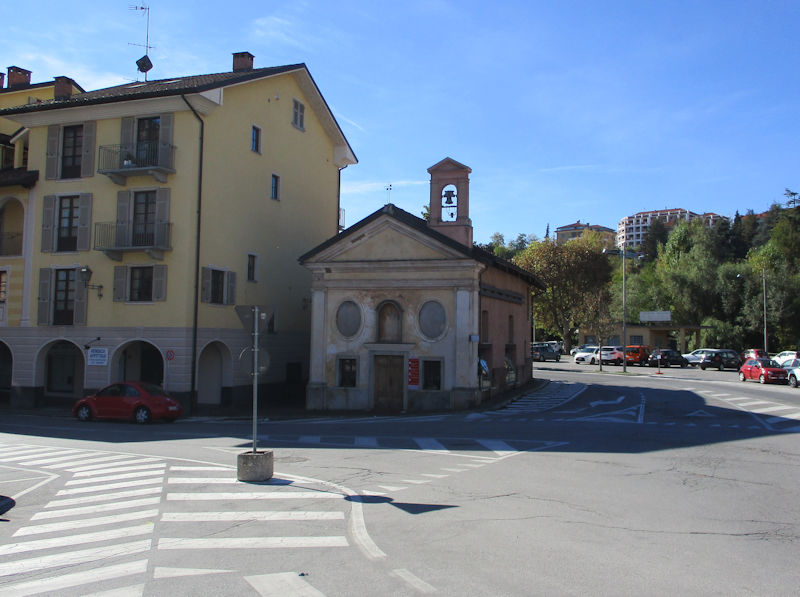
The Piazza Ellero where the little river passes through town
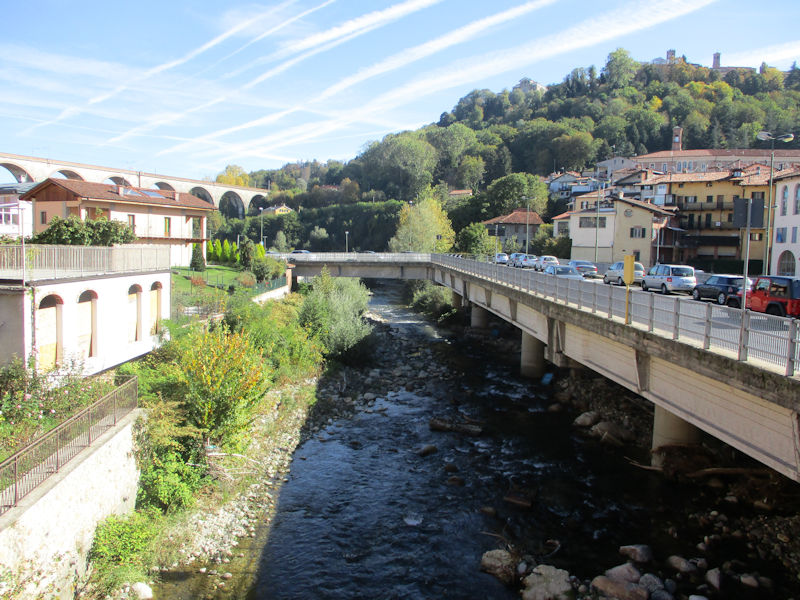
The mighty Ellero, a 35km tributary of the Tanaro
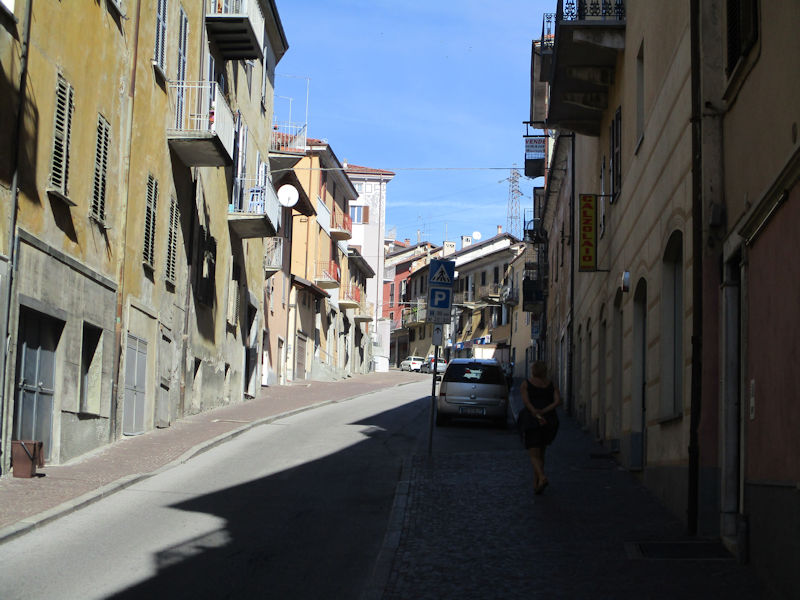
We're looking for the Via delle Ripe, and this is it . . .
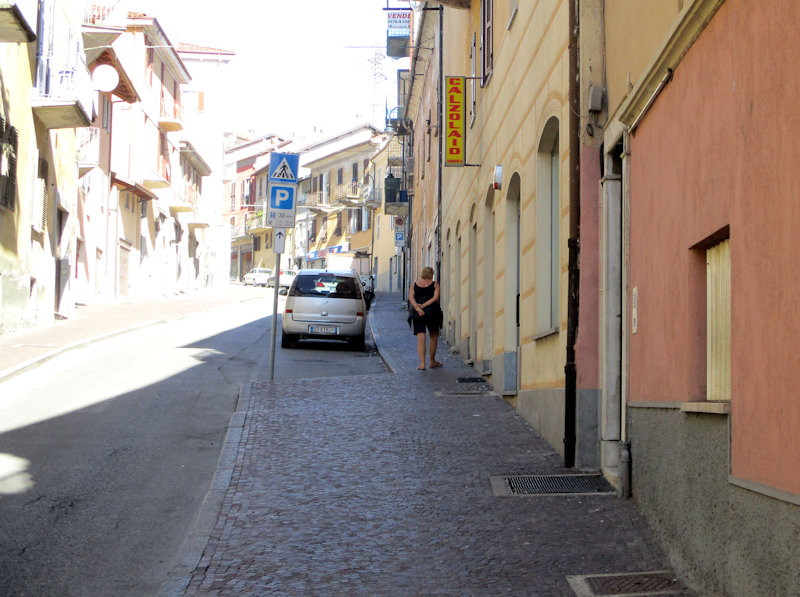
. . . specifically for the shoe repair man, and he's closed for lunch. We've brought a small sack of ladies' shoes to have resoled and will have to come back later.
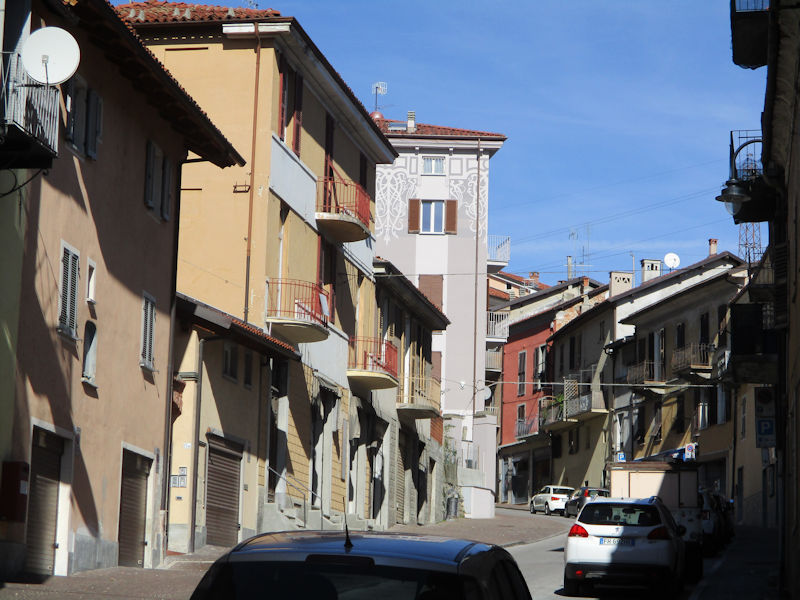
The Via delle Ripe

The Fiume Ellero -- evidently it's known for good kayaking, but surely not here.

The Belvedere clock tower and Duomo belltower from the riverside
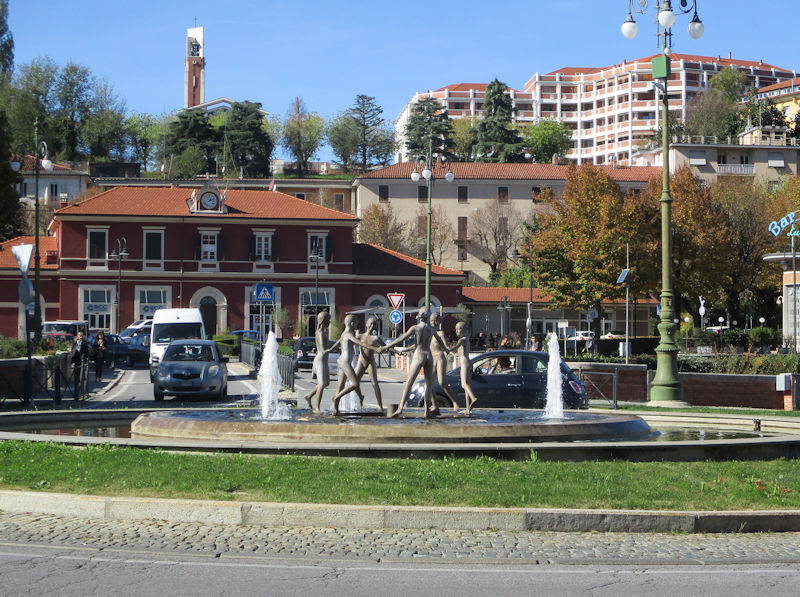
An exuberant installation at the roundabout at the southern end of the long Piazza Ellero

Mondovì street scene (we're looking for something else now, but I can't recall what)
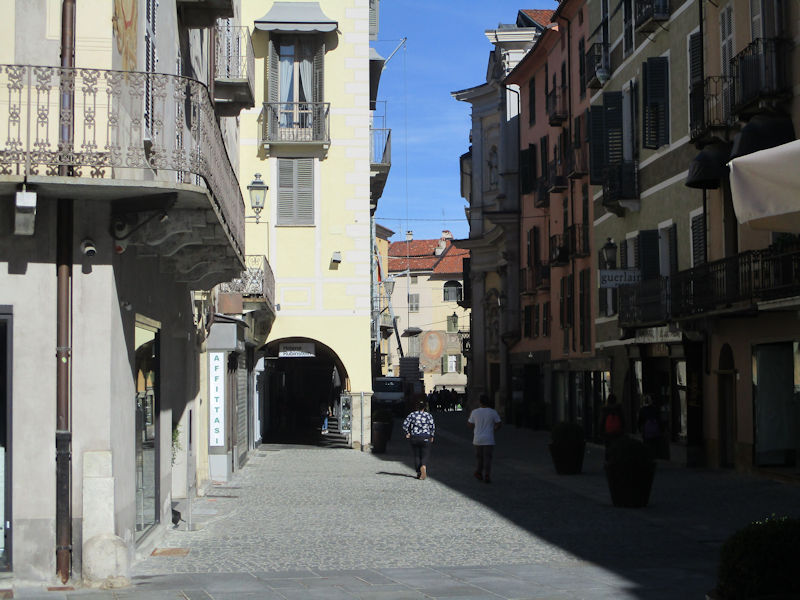
Along the Via Piandevalle
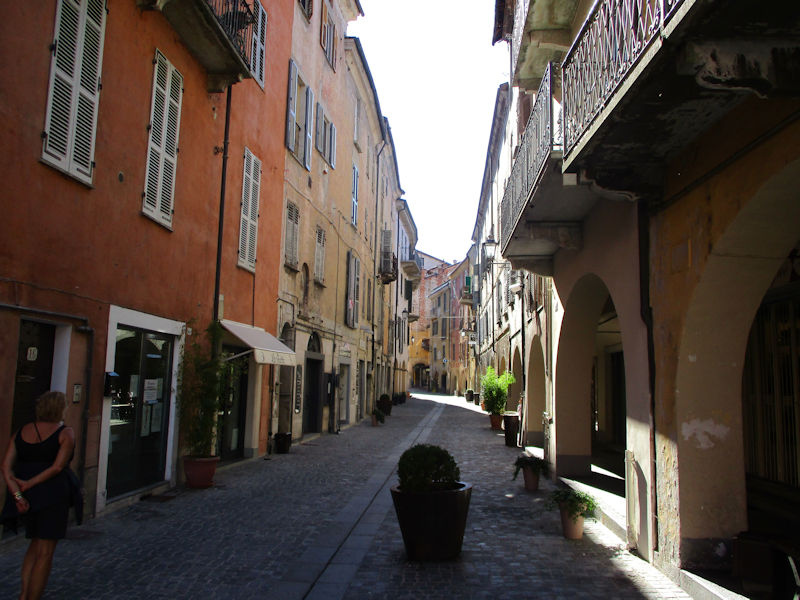
Same
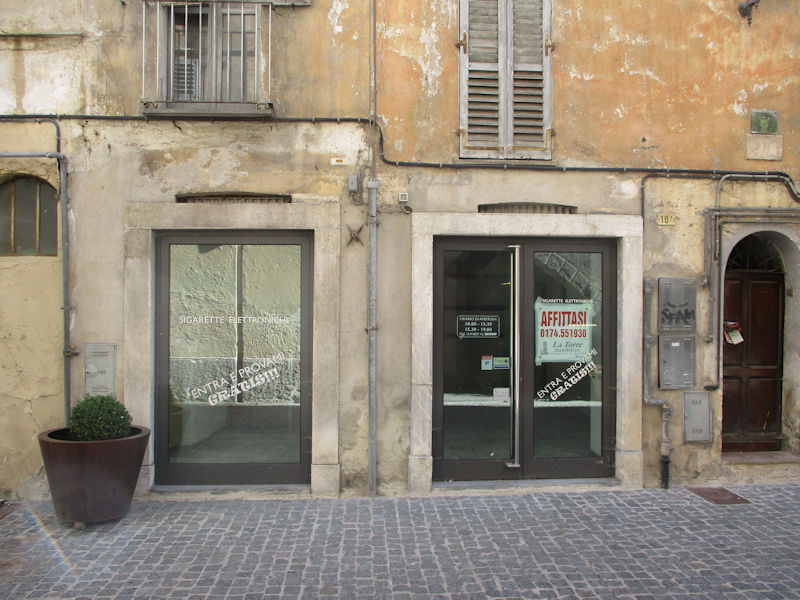
'Electronic Cigarettes: Come In and Try Them, Free'
(For Rent)
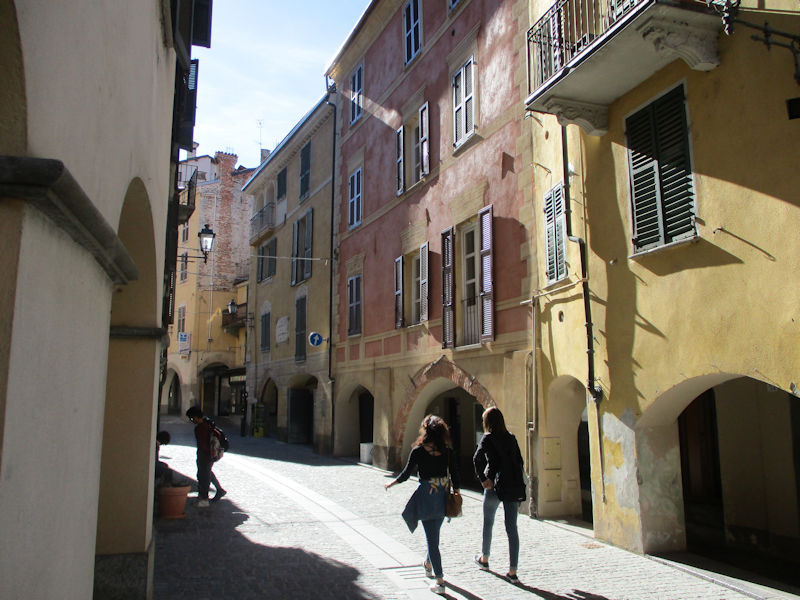
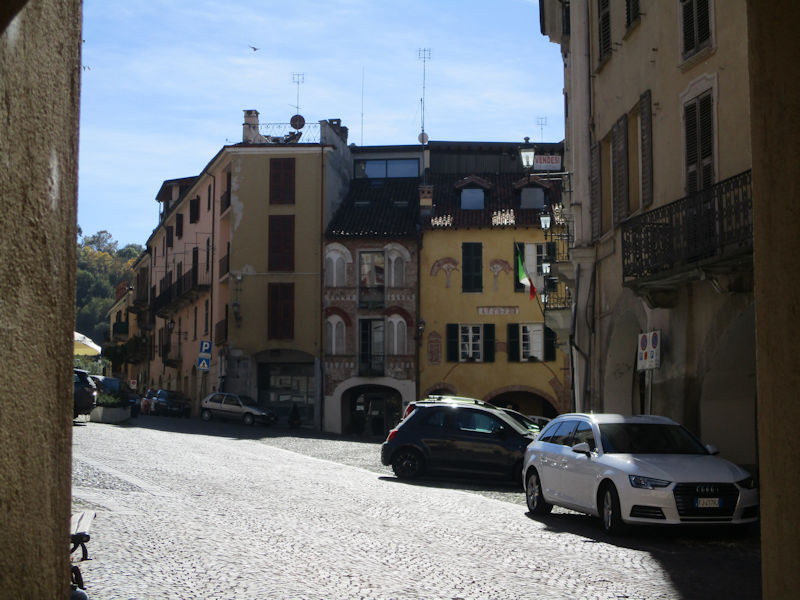
Time for lunch
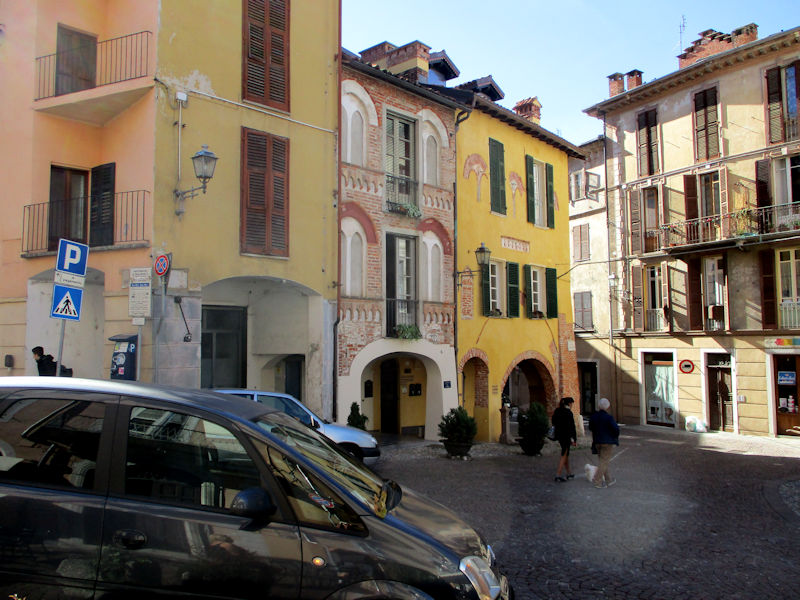
The view from a nice sidewalk cafe and wine bar with good pasta dishes, Il Ciottolo, in the Piazza S. Maria Maggiore
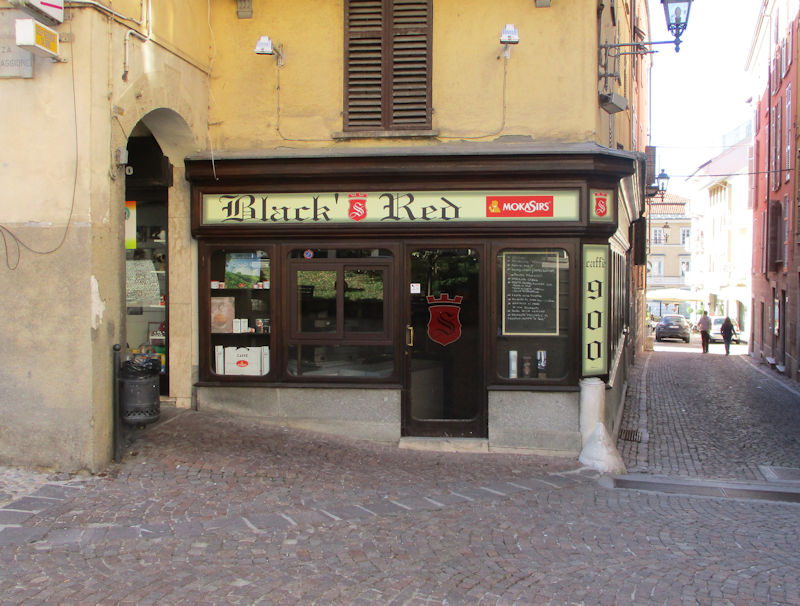
That seems to be the Black' Red ("pub")
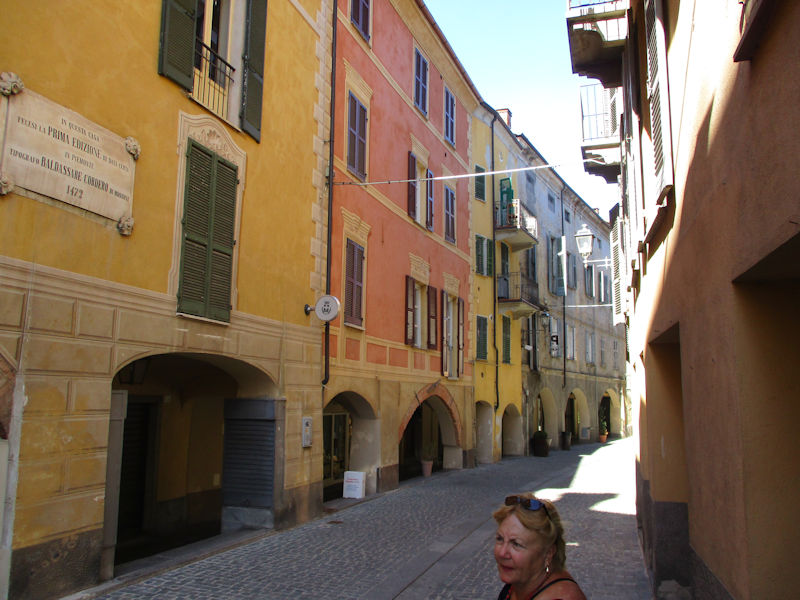
This is the home of the man (Baldassarre Cordero) who financed the printing of the first book in the Piedmont region using movable type, in 1472.

Along the Via Sant'Agostino
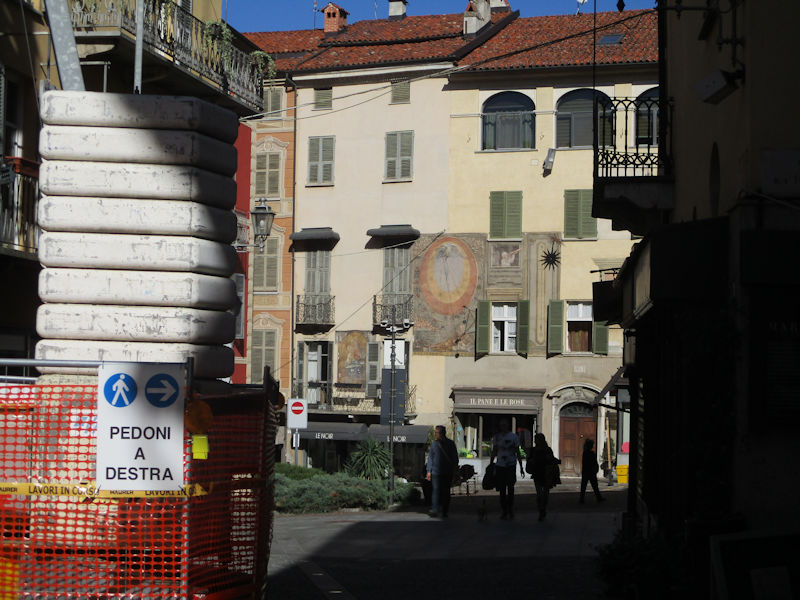
Back to the Piazza S. Pietro and . . .
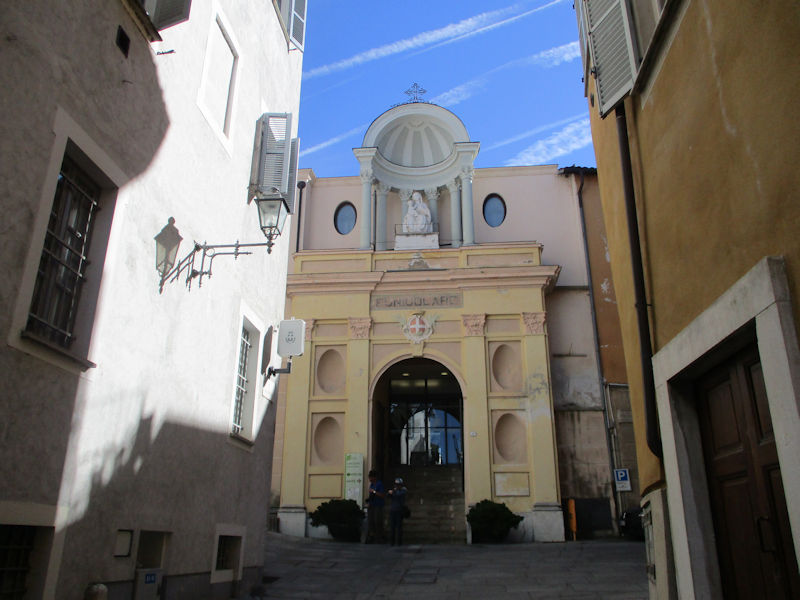
. . . up the street to the funicular
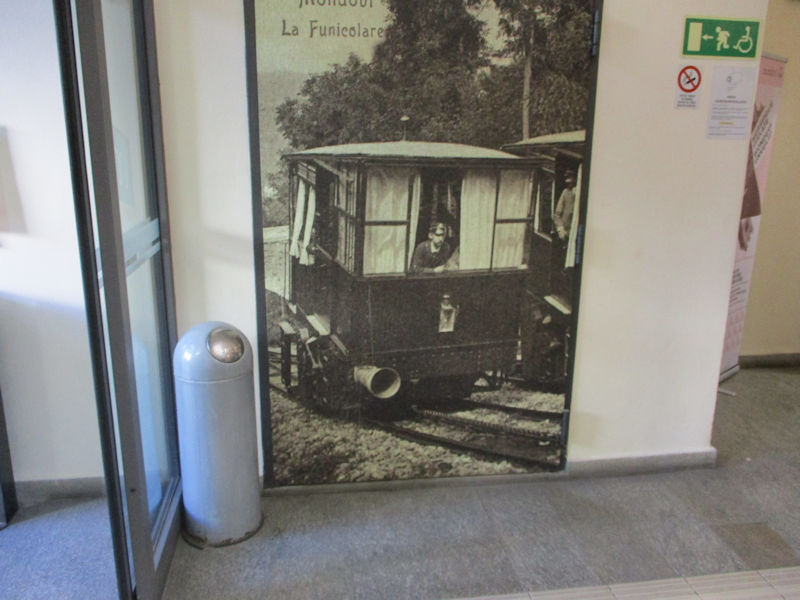
The new cars inspire much more confidence.

Melvin relaxing on the balcony with a good book
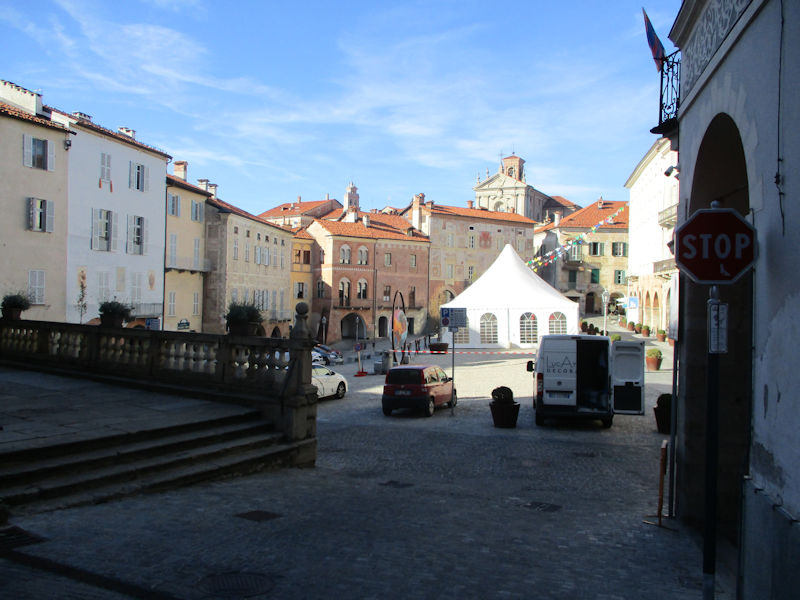
Off for another perambulation -- the Piazza Maggiore from the southern end

An odd old building, unidentified, where the Via S. Pio V and the Via Giovanni Giolitti bifurcate.
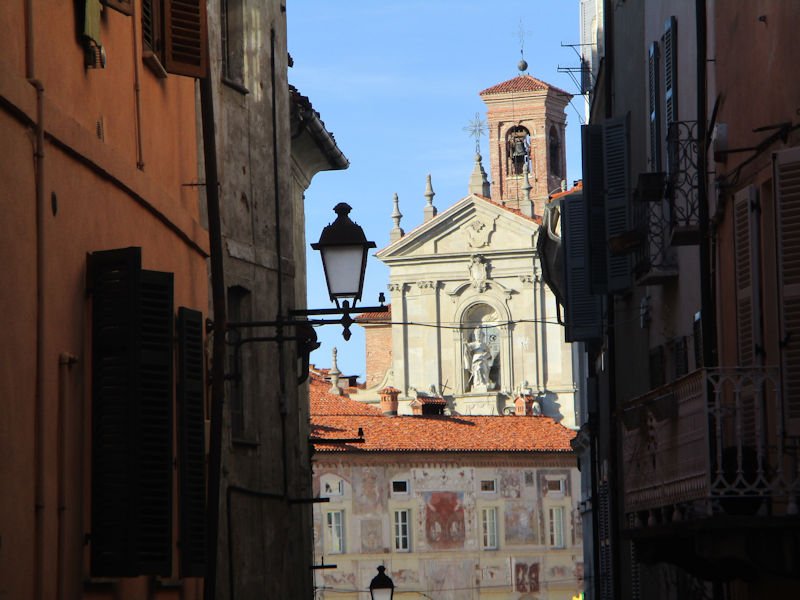
The Governors' Palace and the Duomo zoomed from Giolitti street up the hill a ways
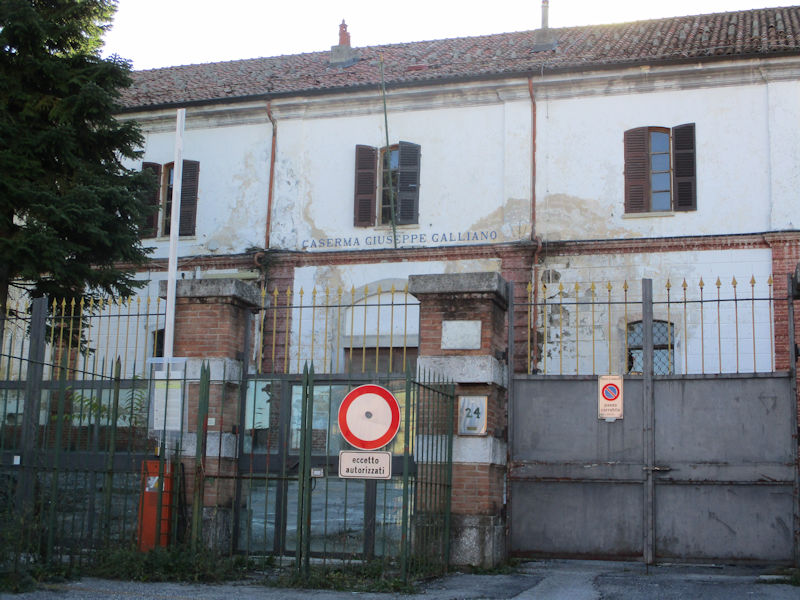
The Caserma, or Barracks, Giuseppe Galliano. Here at the top of the other high point on Monte Regale, opposite the Belvedere and Duomo, Duke Emmanuel Philiberto cleared the area of churches and built his Citadel in 1573-1576. The 4,000m2 fortress served the Savoyard military and was later handed over to the precursor to the Guarda di Finanza, until the present buildings were built in 1874 to become the local HQ of an Alpini military regiment. In 1943-45 the German Wehrmacht quartered here and used it for a prison, then from 1953 it was back with the Mondovì regiment of the Alpini, and from 1972 with the Guardia di Finanza again, before being turned over to the use of the Municipality in about 1999.
Since then there seems to have been a great deal of controversy about what to do with the facility, given the costs involved in preparing it for a new life. In 2014 John Aimo, a local balloonist, took photographs of the former Citadel from his balloon, published in La Stampa of Torino, deploring the state of degradation of the former barracks complex and describing it as 'an open wound in the heart of Mondovì'. More recently (in fact today, as I write, 28 November 2018), L'Union Monregalese has a piece about the Mondovì mayor's frustrated call for a coherent plan for the use of the Galliano facility; the project for an 'enogastronomic campus' in collaboration with an hotelier is said still to be on the table.
The barracks are named for Lt-Col Galliano (1846-1896) of the Alpini, a hero in Italy's wars in the 1890s in its Eritrean colony.
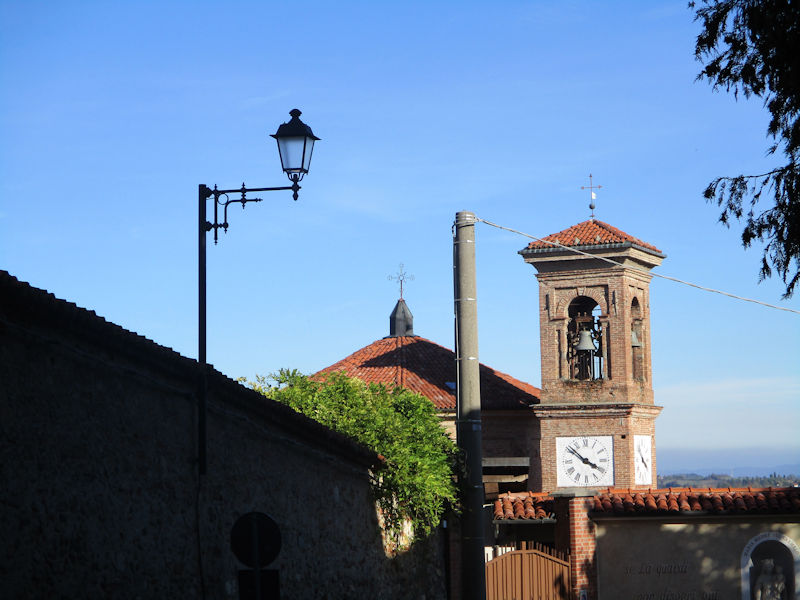
Steeply down the Via Emanuele Filiberto Baluardo

A little alley down past the Church of San Giuseppe dei Carmelitani, the first church built by Francesco Gallo, consecrated in 1717.

Then on the Via Vico up the hill back to the Piazza, past our most favorite restaurant, the Pizzeria La Piemontese, and the little grocery and beer/wine shop for which we were exceedingly grateful.

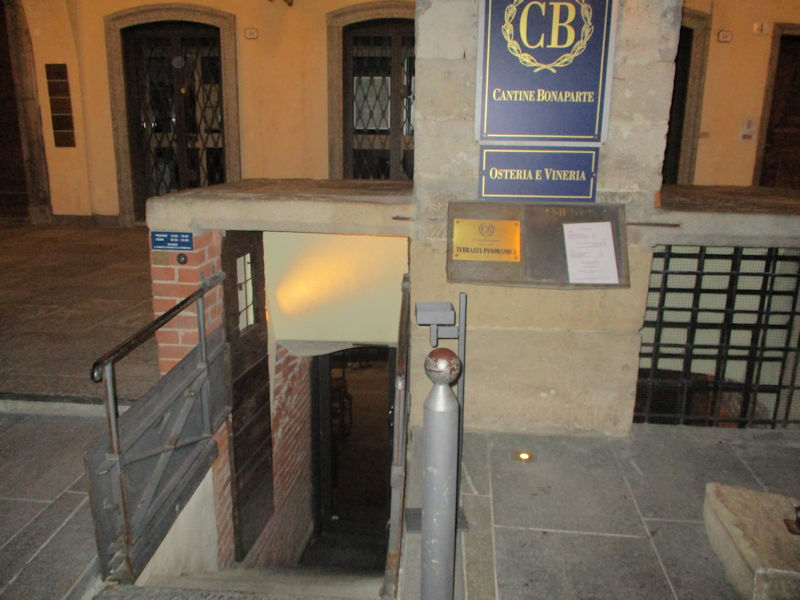
But tonight it's back to our other most favorite restaurant, the subterranean Cantine Bonaparte.

Charming ambiance -- empty for the moment because we are always the first people in the door.


End of the day. Tomorrow, Cuneo and the Staffarda Abbey

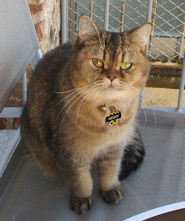 Dwight Peck's personal website
Dwight Peck's personal website





































































